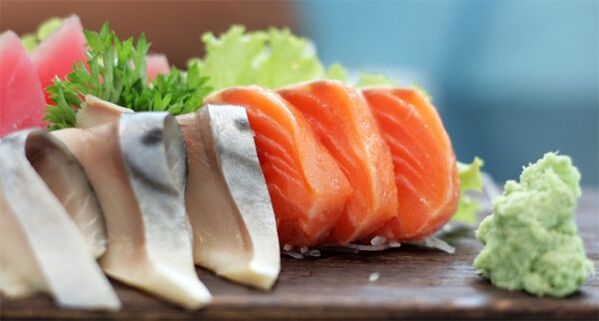Although rolls and sushi seem dietary and low-calorie compared to other dishes, the 14-day Japanese diet does not rely on them. It got its name because its fulfillment required the endurance and fortitude of a noble samurai. He's really complicated. But the efforts are worth it: kilograms are really lost during this diet, and in the future it is easy to switch to a classic healthy diet, which will not allow you to regain what you lost.
Japanese method of losing weight: menu and recommendations
The Japanese 14-day diet is very strict. It will distract you from familiar tastes, "clear your receptors" and allow you to feel the taste of healthy food. Look at it not as a grind or overcoming obstacles, but as an introduction to something foreign that has existed right under your nose your whole life.
The main principles of this diet are categorical:
- salt and all other spices are strictly prohibited;
- The menu is very tightly organized. Moreover, not only what to eat is prescribed, but also exactly how much. In grams;
- In your opinion, you cannot even replace products with equivalent analogues;
- It is recommended to take multivitamins throughout the diet, because due to the limited range of food the body does not receive the necessary substances in sufficient quantities;
- Active sports are prohibited in parallel with the diet;
- Exit from the diet is carried out according to strict rules. If these are neglected, the body will be subjected to too much stress, which can lead to problems.
If you follow all the rules, your stomach will decrease in size within 2 weeks and you will start eating less after leaving the diet. The main thing is to continue eating in moderation so as not to yawn again.
Most likely, you already know what proper nutrition is: eating vegetables and diet meat without spices. If this seems inadequate and tasteless to you, the "Japanese" diet will definitely change your mind. You'll begin to taste foods that previously seemed bland and learn to enjoy the juicy crunch of vegetables.

Recently, mini versions of the Japanese diet have appeared. They may seem easier to endure because they are designed for fewer days. But it is not like that. After a few days of "Japanese" nutrition, the body gets used to it and eating becomes comfortable. So the short version of the diet will bring exactly the same amount of discomfort and then end up losing less weight.
There is one more trick. In the first days of the diet, weight is lost mainly due to salt and fluid loss. And only then the stomach shrinks and the metabolism changes, which allows you to maintain the resulting form for a long time. If you stop at the stage of removing water and salt, they will return to their previous places when you return to your normal diet.
Contraindications
The Japanese diet creates emergency conditions for the body, as it destroys fat reserves. It is not particularly diverse and many important items will be temporarily missing. Hence the contraindications to the Japanese diet:
- pregnancy and breastfeeding period. The child must receive the necessary substances without restrictions; Deficiency causes developmental disorders. Therefore, wait until your baby starts eating on his own;
- problems with the circulatory system: a large load is placed on it during the diet;
- diseases of the digestive and endocrine systems.
List of allowed foods
Another advantage of the 14-day Japanese diet is that it is cheap. All products are sold in every store and are not at all expensive compared to the banned ones.
It is best to go to the store and make a strategic reserve for the first time before starting the diet. Those who have tried the described diet say that the first days are especially difficult to endure, and a trip to a store full of temptations can cause a collapse.
By the way, it is dangerous to break away from the salt-free regime: the body is in acute salt deficiency mode, and it is dangerous to sharply increase its amount.
Here's what you should eat for two weeks:
- Fresh fruits low in sugar: citrus fruits, green apples, pineapples, plums, cherries and others;
- Fresh non-starchy vegetables: white cabbage, carrots, zucchini, eggplant, tomatoes;
- Freshly squeezed tomato juice;
- Absolutely unprocessed, unrefined olive or sesame oil;
- Yoghurt, kefir without filler;
- Cheese with minimum fat content but without salt;
- The meat is an extremely lean, skinless fillet. Beef, chicken, fish;
- Eggs. By weight, one chicken egg corresponds to 5 quail eggs;
- Black coffee. You cannot add anything to it, it is undesirable to replace it with soluble;
- Tea is also the simplest, most natural;
- Clean drinking water without gas;
- Rusks from slices of rye bread without dried fruit.
By the way, if you add lemon juice to unsalted food, you will get a very interesting taste, which makes it easier to get rid of spices.

Prohibited Products
Strictly speaking, all products not specified in the algorithm are prohibited. To be on the safe side, we will stipulate what exactly needs to be removed from the refrigerator and in an easily accessible place before starting to implement the "Japanese" regime.
- Unauthorized vegetables and fruits;
- salo;
- Dairy products;
- Smoked meats;
- Bakery products, desserts;
- Store-bought beverages, especially alcoholic beverages;
- Flavoring additives.
All menu
It's hard to forget that the Japanese 14-day diet is one of the really difficult ones to follow. Once you decide to do it, stick with it for the entire stipulated period, do not interrupt or shorten it.
The algorithm assumes three meals a day (breakfast, o-lunch, y-dinner), without snacks and treats.
- Monday
- h – Coffee;
- o – Coleslaw, 2 eggs, juice of a few tomatoes;
- y – 200g fish from the steamer.
- Tuesday
- h – Coffee and 1 cracker;
- o – Steamed fish, coleslaw;
- y – 100 g beef, kefir;
- Wednesday
- h – Coffee and 1 cracker;
- o – A few eggplants sauteed with a small amount of oil;
- y - 200 g of beef from the oven, coleslaw, a few eggs;
- Thursday
- h – Carrot salad;
- o - 200 g of fish from the steamer, tomatoes;
- y – Sour fruits;
- Friday
- h – Carrot salad;
- o - 200 g of fish from the steamer, tomatoes;
- y – Allowed fruits;
- Saturday
- h – Coffee;
- o – Baked chicken fillet, carrot and cabbage salad;
- y – 2 eggs, raw carrots;
- Sunday
- h – Tea;
- o - 200 g of beef from the oven;
- y – Any offer of your choice for this week, but not fruity.
Sticking to your diet may be difficult at first. However, with each passing day, the body will get more used to this and switch to a new working mode. The dish will show its true taste. You will lose the habit of feeling full after eating. The first results of the Japanese diet will be noticeable. This diet does not force you to starve, but it prevents you from overeating by gradually reducing the volume of your stomach.
So you have tasted victory, the work continues. Here is next week's schedule (breakfast, o-lunch, o-dinner).
- Monday
- h – Coffee;
- o – Half a kilo of baked chicken fillet, cabbage and carrot salad;
- y - Anything except last week's fruit;
- Tuesday
- h – Carrot salad;
- o - 200 g of fish from a steamer, a few tomatoes;
- y – Sour fruits;
- Wednesday
- h – Coffee;
- o – Carrot salad, egg, a slice of cheese;
- y – Sour fruits;
- Thursday
- h – Coffee with crackers;
- o – Baked or raw zucchini;
- y - 200 g of beef from the oven, coleslaw, a few eggs;
- Friday
- h – Coffee;
- o - 200 g of steamed fish, coleslaw;
- y – 200 g of beef from the oven, yoghurt;
- Saturday
- h – Coffee;
- o – Coleslaw, 2 eggs, tomatoes;
- y – 200 g steamed fish;
- Sunday
- h – Coffee;
- o – 200g steamed fish and coleslaw;
- y – 200 g of beef and a glass of kefir.
Coleslaw is strictly made up of 2 ingredients: crispy kale and 20g of fat. Carrots - from carrots and 20 g of butter, respectively.
I would like to note how suitable the Japanese diet is for men. Even those with no cooking skills can handle preparing their own meals without imposing new rules on their loved ones.
Features of following a salt-free diet
During a salt-free diet the body will experience an unusual, almost extreme salt deficiency. This is one of the main secrets of its effectiveness. But for everything to work correctly, you need to adhere to important principles:
- Drink as much as possible. You will need to drink at least 2 liters of clean water a day in small portions. If you do 1 cup at a time you will get about 8 approaches.
- It is best to drink the first glass of water in the morning before breakfast. Better yet, drink a few tablespoons of fiber with this glass. This is a nutritional supplement sold in any pharmacy. Taking it regularly in this way will improve bowel functions and further increase the effectiveness of the diet.
- Don't extend your diet even if you think you can. The maximum time the human body can go without sodium chloride is 14 days.
- It is allowed to gradually add salt in the last days of the diet. You cannot immediately salt food to its usual taste; for the first time, add literally a few crystals of salt and slightly increase the dose.
- If necessary, coffee can be replaced with tea. But it is better to leave it as it is; Coffee normalizes blood pressure and provides the body with antioxidants.
Quitting the Japanese Diet
You will inevitably lose weight within 14 days of following the diet diligently. Your job now is to properly return the sodium chloride. But it's not just about salt. The rules for transition from diet to normal life will allow you to maintain your new body for a long time.
- Continue eating according to the diet algorithm. Definitely add new dishes to the menu one by one.
- Do not increase portion size. Your stomach contracts a little and this is enough to fill you up. If you overeat, the walls of the stomach stretch again, the stomach grows and the weight begins to return.
- Add the salt with great care. A little at first, then gradually return to the normal amount over a few days.
- It is better to stay away from other spices for at least another month. They increase appetite and make it difficult to establish new, healthy eating habits.
Effective diets often make you want to continue or return to them. But you can't do this with the Japanese diet. If you want to extend the experiment, exit the diet wisely, add other vegetables to your diet, diversify your meat dishes, you can strengthen your breakfast a little.
You can return to the Japanese diet only after six months.
Reviews about weight loss results
- "I resisted heroically and I'm proud of myself. By the end of the first week it became a little more familiar, and then things got easier. The hardest thing was not eating cakes and chocolate for such a long time. I had to get used to small portions. The rest is not scary. And you know, a few months passed until I got fat .
- "I found this diet while preparing for the wedding and could not fit into the dress. I managed to lose 10 kilos in 2 weeks in a hurry, until recently no one believed in the success of this experiment! I wore a dream dress with a perfect waist at the wedding. By the way, now I have only gained a few kilos. "
- "I lost weight with Japanese and I don't think it was that heavy. We lost 7 kg. I switched from dieting to a healthier diet than I was used to and did not gain weight. 7 years later I got pregnant and of course I could not spare time for my body and gained about 13 kg. Now I breastfeed my baby and it is good for him "I have to eat what comes. As soon as I stop breastfeeding, I will definitely go through these 14 days of asceticism again to get back in shape. I have 100% confidence in this diet. "
















































































